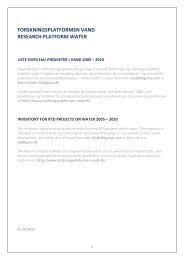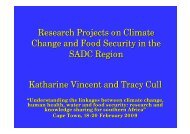energy strategy 2050 - Energy Europe
energy strategy 2050 - Energy Europe
energy strategy 2050 - Energy Europe
Create successful ePaper yourself
Turn your PDF publications into a flip-book with our unique Google optimized e-Paper software.
New challenges and new opportunities for <strong>energy</strong> policy<br />
Security of supply under pressure<br />
The world’s population will increase towards 9 billion by<br />
<strong>2050</strong>. Many people will become wealthier and as a consequence,<br />
the demand for <strong>energy</strong> for electricity, heating,<br />
transport and industry will increase. Within the next 25<br />
years alone, it is expected that the world’s total <strong>energy</strong><br />
consumption will grow by approximately 34% according<br />
to calculations by International <strong>Energy</strong> Agency, IEA. This<br />
development is driven primarily by a growing demand in<br />
large developing countries and growth economies such<br />
as China and India.<br />
18,000<br />
16,000<br />
14,000<br />
12,000<br />
10,000<br />
8,000<br />
6,000<br />
4,000<br />
2,000<br />
0<br />
1990 1995 2000 2005 2010 2015 2020 2025 2030 2035<br />
Mto<br />
China<br />
United States<br />
<strong>Europe</strong>an Union<br />
India<br />
Middle East<br />
Japan<br />
Inter-regional (bunkers)<br />
Rest of world<br />
Figure 1.2. World primary <strong>energy</strong> demand by region up to<br />
2035 (scenario based on national climate and <strong>energy</strong> policy<br />
targets).<br />
(World <strong>Energy</strong> Outlook © OECD/IEA, 2010)<br />
As the need for <strong>energy</strong> grows, ever fewer fossil fuels will<br />
be available. In particular, the world’s oil reserves will be<br />
exhausted more quickly than new oil fields are discovered.<br />
Furthermore, for part of the remaining oil, extraction<br />
involves considerable environmental challenges.<br />
This applies, for example, to oil in the Arctic regions or to<br />
deepwater oil fields. Furthermore, it applies to oil production<br />
from natural gas and coal, tar sand and oil shale.<br />
As regards natural gas production, the situation is<br />
less critical, at least in the short and medium term. As<br />
regards coal, global occurrences are plentiful, but other<br />
factors, primarily the consideration for the global climate,<br />
necessitate limited use.<br />
In addition to this pressure on reserves, the world’s oil,<br />
and to a certain extent natural gas resources as well, are<br />
increasingly concentrated in just a few countries. Thus,<br />
the OPEC countries will account for an ever growing<br />
share of global oil supply, as illustrated in figure 1.3.<br />
Saudi Arabia<br />
Iraq<br />
Brazil<br />
Kazakhstan<br />
Canada<br />
Venezuela<br />
UAE<br />
Kuwait<br />
Iran<br />
Qatar<br />
Nigeria<br />
Libya<br />
Algeria<br />
0 1 2 3 4 5<br />
OPEC<br />
Non-OPEC<br />
mb/d<br />
Figure 1.3. Incremental oil production by key country, 2009-<br />
2035<br />
(World <strong>Energy</strong> Outlook © OECD/IEA, 2010)<br />
12<br />
<strong>Energy</strong> Strategy <strong>2050</strong> – from coal, oil and gas to green <strong>energy</strong>.
















